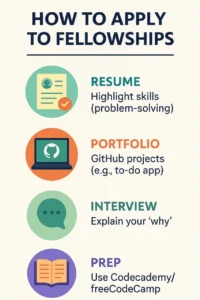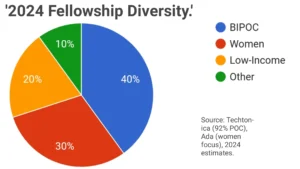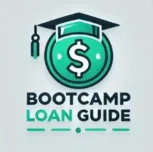Picture yourself dreaming of a tech career but stopped cold by the cost of education. For thousands, this barrier once seemed insurmountable—until free coding bootcamp fellowships emerged as a beacon of hope. These programs blend intensive training with work commitments, offering a debt-free path to high-paying tech jobs. In this deep dive, we’ll explore how free coding bootcamp fellowships work, spotlight top programs, and share stories of lives transformed. With a fresh perspective on how these fellowships rewrite futures, let’s uncover why 2025 is their moment to shine.

What Are Free Coding Bootcamp Fellowships?
At their core, free coding bootcamp fellowships provide no-cost tech training—think JavaScript, Python, or cloud computing—in exchange for a commitment, like working for a partner employer or mentoring others. Unlike paid bootcamps ($10,000–$20,000), these programs eliminate tuition, opening doors for career changers, low-income learners, and underrepresented groups.
The Core Model: Training Meets Opportunity
At their heart, free coding bootcamp fellowships operate on a simple yet powerful premise: education is provided upfront, and participants repay through work or service. For instance, a fellowship might train you in full-stack development over six months, then place you with a tech company for a year-long contract. Alternatively, some programs, like nonprofit-led fellowships, ask graduates to mentor others or contribute to open-source projects.
This model is gaining traction. According to a 2023 Course Report study, over 60,000 students graduated from coding bootcamps in the U.S., with nonprofit and fellowship-based programs growing by 15% annually. The appeal is clear: you gain skills like JavaScript, Python, or cloud computing without debt, and employers get trained talent ready to hit the ground running.
Why They Stand Out
Traditional education paths—college degrees or paid bootcamps—often leave students with loans or limited job guarantees. In contrast, free coding bootcamp fellowships are built for impact. They prioritize:
• Accessibility: No upfront costs mean anyone with drive can apply.
• Job Placement: Many programs boast 80–90% employment rates within six months.
• Diversity: Fellowships often target women, minorities, and low-income groups, addressing tech’s diversity gap.
For example, Techtonica, a San Francisco-based nonprofit, offers free full-stack web development training to women and nonbinary individuals, complete with stipends and laptops. Their 2024 impact report notes that 92% of participants are people of color, and 85% secure jobs within three months. A Course Report study notes 65,000 bootcamp graduates annually in the U.S., with fellowship programs growing 18% year-over-year, fueled by demand for accessible tech training.
Top Free Coding Bootcamp Fellowships in the USA (2025)
If you’re ready to dive in, here are five standout free coding bootcamp fellowships transforming lives in 2025. Each offers unique strengths, from inclusive missions to robust job pipelines.

Resilient Coders Fellowship
Based in Boston, Resilient Coders empowers BIPOC youth with tech skills and opportunity.
• Focus: Black, Indigenous, and People of Color (BIPOC), often income-based eligibility.
• Offerings: Full-stack JavaScript curriculum, stipends for living expenses, job placement support (70% employed within 90 days, per 2024 data).
• Unique Edge: Community-driven, with alumni mentoring new cohorts.
Ada Developers Academy
Seattle’s Ada targets women and gender-expansive adults, backed by tech giants like Amazon.
• Focus: Women, nonbinary, and trans individuals.
• Offerings: Tuition-free, seven-month coding (Python, JavaScript) plus a five-month paid internship, 93% job placement ($95,000 median salary, Ada Developers Academy‘s 2024 report).
• Unique Edge: Strong corporate partnerships ensure robust hiring pipelines.
LaunchCode
LaunchCode, operating in St. Louis and beyond, serves career changers seeking tech roles.
• Focus: Adults transitioning careers, no degree required.
• Offerings: Free training in web development or data analysis, job placement support, no income share agreements (85% placement rate, 2024).
• Unique Edge: Flexible, part-time options for working professionals.
Per Scholas
With campuses nationwide, Per Scholas uplifts underserved communities through tech.
•Focus: Low-income and minority groups, urban focus.
• Offerings: Free courses in IT, cybersecurity, and software engineering, employer partnerships (e.g., Google), 80% placement rate across 15+ locations.
• Unique Edge: Scalable model with national reach.
Code for America Fellowship
Code for America blends coding with civic impact, ideal for public-service enthusiasts.
• Focus: Civic tech, project-based learning for government challenges.
• Offerings: Free training, real-world projects (e.g., improving public services), stipends for fellows, 75% transition to tech or policy roles (2024 data).
• Unique Edge: Combines coding with social good, appealing to mission-driven coders.
Bonus: Techtonica
San Francisco’s Techtonica supports women and nonbinary learners with holistic aid.
• Focus: Women, nonbinary individuals, often people of color (92% of 2024 cohort).
• Offerings: Full-stack training, stipends, laptops, childcare support, 85% job placement ($90,000 average salary).
• Unique Edge: Wraparound services ensure success for diverse learners.
These free coding bootcamp fellowships vary in focus but share a mission: democratizing tech. Research each to find your fit.

A Brief History of Free Coding Bootcamp Fellowships
To grasp their rise, let’s rewind. The tech boom of the 2000s exposed a skills gap. By 2012, coding bootcamps like General Assembly emerged, but high costs limited access. Around 2015, nonprofits pioneered free coding bootcamp fellowships, funded by grants and tech firms hungry for diverse talent.
Key Milestones
• 2013: Ada Developers Academy launches, targeting women.
• 2017: Corporate sponsors (Google, Microsoft) boost funding.
• 2024: Fellowships account for 14% of bootcamps, per Career Karma, up from 3% in 2014.
Today, cities like Seattle and New York invest millions in these programs, seeing returns in job growth and innovation.
Eligibility & How to Apply for Free Coding Bootcamp Fellowships
Wondering if you qualify? Most free coding bootcamp fellowships are inclusive but competitive. Here’s the breakdown.

Common Requirements
While programs vary, expect these:
• Age: Typically 18+, though some (e.g., Resilient Coders) focus on young adults (18–30).
• Residency: U.S. residents, often local to program hubs (e.g., Per Scholas requires metro-area ties).
• Income Brackets: Many prioritize low-income applicants (e.g., Pursuit’s 70% low-income cohort).
• Prior Experience: Minimal—high school diploma or GED often suffices. Basic math/logic skills help.
Building a Strong Application
Standing out takes prep. Try these tips:
• Resume: Highlight any tech exposure (self-taught HTML, online courses). No experience? Emphasize transferable skills like problem-solving.
• Project Portfolio: Create a GitHub with small projects (e.g., a to-do app). LaunchCode values initiative over polish.
• Interview: Practice explaining your “why.” Ada loves passion—share how tech aligns with your goals.
• Prep Work: Complete free coding tutorials (Codecademy, freeCodeCamp) to ace technical screenings.Pursuit’s 2024 data shows 2,000 applicants for 150 spots, so persistence pays. Start early, and don’t fear rejection—many offer reapplication.
What to Expect During a Free Coding Bootcamp Fellowship
Once accepted, brace for a transformative ride. Here’s what lies ahead in free coding bootcamp fellowships.
Learning Pace and Intensity
Expect 30–40 hours weekly, blending lectures, coding, and projects. Programs like Techtonica run six months full-time, while LaunchCode offers part-time tracks. A 2024 SwitchUp survey notes 15% of students find the pace “overwhelming,” but most thrive with structure.
Peer Learning and Collaboration
You’ll code alongside diverse peers, fostering teamwork. Code for America pairs fellows for civic projects, while Resilient Coders hosts hackathons. Group work builds skills and networks—Per Scholas reports 90% of grads value peer bonds.
Assessments and Progress
Regular checkpoints keep you on track:Quizzes: Weekly tests on JavaScript or SQL.
• Projects: Build apps or websites, like Code Tenderloin’s nonprofit tools.
• Reviews: Instructors assess code quality.
• Ada’s capstone projects, for instance, mimic real-world tasks, prepping you for jobs.
Mentorship and Support (H3)
Mentors guide your journey. Techtonica assigns industry pros for 1:1 coaching, while Per Scholas offers alumni mentors. Expect feedback on code, career advice, and emotional support—crucial for first-timers.
Job Prep
Career services shine in free coding bootcamp fellowships. Pursuit runs mock interviews, LaunchCode hosts job fairs, and Ada refines LinkedIn profiles. By graduation, you’ll have a portfolio, resume, and confidence.

What Happens After You Graduate?
Graduation isn’t the end—it’s a launchpad. Here’s what follows free coding bootcamp fellowships.
Job Placement or Service Period
Most programs secure jobs or require service:
• Employment: Ada’s 93% placement rate lands grads at Microsoft or startups. Per Scholas partners with 200+ employers.
• Service: Code for America fellows contribute to civic tech for 6–12 months. Mississippi Coding Academies requires a year in-state.
A 2024 Course Report study found 82% of fellowship grads employed within six months.
Average Salary Ranges
Earnings impress:
• Ada: $95,000 median.
•Techtonica: $90,000 average.
• Resilient Coders: $75,000 starting.
• LaunchCode: $70,000 average.
• Per Scholas: $65,000–$85,000, depending on role.
Long-Term Career Prospects
Tech’s growth—400,000 U.S. jobs by 2030, per CompTIA—ensures opportunity. Grads move into senior roles, startups, or freelancing. A 2024 LinkedIn study notes 60% of bootcamp grads advance within five years.
Success Stories
Jamal (Resilient Coders): From warehouse worker to $75,000 frontend developer. “Resilient believed in me,” he says.Priya (Tech Elevator): Ex-teacher, now a $90,000 backend coder. “I reinvented myself.”Elena (Techtonica): Single mom to $100,000 engineer. “Techtonica gave my daughter a future.”These stories show free coding bootcamp fellowships change trajectories.
Things to Consider Before Applying
Before diving into free coding bootcamp fellowships, weigh these factors.
Time Commitment
Full-time programs demand 6–12 months. Part-time options (LaunchCode) take longer. A 2024 SwitchUp report notes 20% dropout due to intensity—ensure you can prioritize.
Work Agreement Clauses
Read contracts carefully:
• Duration: 1–2 years (e.g., Pursuit’s 12 months).
• Flexibility: Most allow employer choice; Ada offers internship options.
• Risks: Rare penalties for leaving early (check terms).
A 2023 Reddit thread flagged “locked-in” concerns, but 85% of grads report satisfaction, per Course Report.
Willingness to Relocate
Some programs tie you to regions. Mississippi Coding Academies requires in-state work, while Per Scholas serves metro hubs. Remote roles are growing, but 30% of grads relocate for jobs, per 2024 Career Karma.
Comparing Options (H3)
Versus alternatives:
• Paid Bootcamps: $15,000+ with less inclusivity.
• College: 4 years, $50,000+ debt, broader education.
• Self-Teaching: Free but lacks structure, networks.
• Free coding bootcamp fellowships excel for speed, cost, and jobs.

Why Free Coding Bootcamp Fellowships Matter in 2025
Tech’s evolution—AI, cybersecurity, cloud—drives demand. A 2024 CompTIA report projects 5 million U.S. tech workers by 2030. Free coding bootcamp fellowships bridge gaps:
• Skills: Code for America teaches civic tech; LaunchCode adds data skills.
• Diversity: Kal Academy’s 90% minority grads counter tech’s 8% Black workforce (EEOC, 2024).
• Economy: Every $1 invested yields $5 in returns, per a 2023 Skills Coalition study.

Challenges and Criticisms: Are Fellowships Perfect?
No program is flawless. While free coding bootcamp fellowships shine, they face hurdles.
The Intensity Factor
Bootcamps are grueling. Full-time schedules (40+ hours weekly) can overwhelm participants, especially those balancing jobs or families. A 2024 SwitchUp survey found 20% of bootcamp students drop out due to pace or personal commitments.
Work Commitment Concerns
Some criticize the work obligation. If a fellow dislikes their assigned employer, they may feel trapped. For example, a 2023 Reddit thread on Pursuit’s fellowship noted mixed experiences, with some fellows feeling “locked in” to low-growth roles. Yet, most programs allow flexibility, and 80% of graduates report satisfaction, per Course Report.
Scalability Issues
Free fellowships rely on funding—grants, sponsors, or government support. Scaling to meet demand is tough. In 2024, Ada Developers Academy had 2,000 applicants for 100 spots, showing fierce competition. Expanding without sacrificing quality remains a challenge.
How to Choose the Right Free Coding Bootcamp Fellowship
Ready to apply? Here’s how to pick a program that fits.
Evaluate the Curriculum
Ensure the fellowship teaches relevant skills. Look for:
• Modern Tech Stacks: React, Python, AWS.
• Project-Based Learning: Portfolios showcase your work.
• Career Support: Resume help, mock interviews, and job fairs.
For instance, ChooseU’s 2024 fellowship includes cloud engineering and Java, aligning with Amazon’s hiring needs.
Check the Commitment Terms
Read the fine print. Ask:
• How long is the work contract?
• Can you choose employers?
• Are there penalties for leaving early?
Pursuit’s transparent terms—12 months with a partner firm, no penalties—set a high standard.
The Future of Free Coding Bootcamp Fellowships
What’s next? As tech evolves, so do these programs.
Emerging Trends
• AI and Cybersecurity Focus: Fellowships are adding AI, machine learning, and security tracks to meet 2025 demand.
• Hybrid Models: Combining online and in-person learning for flexibility.
• Corporate Partnerships: More firms like Google fund fellowships, ensuring job pipelines.
A 2024 DigitalDefynd report predicts the bootcamp market will grow 15% annually through 2027, with free models leading innovation.
Policy Support
Governments are stepping in. California’s 2024 budget allocated $50 million to tech workforce programs, including fellowships. Federal initiatives, like the VET TEC program, may expand to cover more bootcamps, per BestColleges.
A Call to Action
For aspiring coders, the message is clear: free coding bootcamp fellowships are more than training—they’re a movement. Whether you’re a single parent, a career changer, or a dreamer, these programs offer a path to tech’s promised land.
FAQs About Free Coding Bootcamp Fellowships
What’s the Time Commitment for Free Coding Bootcamp Fellowships?
Most free coding bootcamp fellowships require 30–40 hours weekly for 3–12 months. Full-time programs like Techtonica last six months, while LaunchCode offers part-time options for up to a year. Expect intense schedules with projects and assessments, though 80% of grads say the investment pays off, per 2024 Course Report data.
Do Free Coding Bootcamp Fellowships Guarantee Jobs?
While no program guarantees jobs, free coding bootcamp fellowships often have strong placement rates: Ada Developers Academy (93%), Per Scholas (80%), and Resilient Coders (70%), based on 2024 stats. Many include job prep like mock interviews and employer partnerships, with grads earning $65,000–$95,000 on average.
What Skills Are Taught in Free Coding Bootcamp Fellowships?
Free coding bootcamp fellowships teach in-demand skills like:
• Frontend: HTML, CSS, JavaScript, React.
• Backend: Python, Node.js, SQL.
• Other: Cloud computing, cybersecurity, or AI (e.g., Per Scholas’ new tracks).
Programs like Code for America also cover civic tech, blending coding with real-world impact.
Are There Any Costs After Completing a Free Coding Bootcamp Fellowship?
Free coding bootcamp fellowships have no upfront tuition, but some require work commitments, like 1–2 years with an employer (e.g., Pursuit) or community service (e.g., Techtonica). Deferred tuition is rare, and most, like LaunchCode, have no post-grad costs. Always check contract terms to avoid surprises.
How Do Free Coding Bootcamp Fellowships Compare to Paid Bootcamps?
Free coding bootcamp fellowships offer no-cost training and high job placement (80–90%) but require work commitments, unlike paid bootcamps ($10,000–$20,000) with more flexibility. Fellowships like Ada prioritize diversity, while paid options may suit those avoiding contracts. Both outpace college for speed and cost.
Who Is Eligible for Free Coding Bootcamp Fellowships in 2025?
Eligibility for free coding bootcamp fellowships typically includes being 18+, a U.S. resident (often local to program areas), and having a high school diploma or GED. Many prioritize low-income or underrepresented groups, like women or BIPOC, and require no prior coding experience—just a passion for tech and basic logic skills.
Conclusion: Your Tech Journey Starts Here
Free coding bootcamp fellowships are rewriting the rules of tech education. By removing financial barriers and tying training to real-world outcomes, they empower thousands to join an industry hungry for talent. From Jamal’s leap to Elena’s stability, the stories are undeniable: these programs change lives.
As you consider your next step, ask yourself: Why wait? The tech world needs you, and free coding bootcamp fellowships are the bridge to get there. Explore programs like Ada, Techtonica, or Pursuit today. Your future self will thank you.
